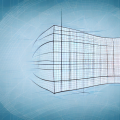The unit circle is a powerful tool that enables learners to visualize mathematical concepts, build their skills, and gain a greater understanding of the relationship between shapes, lines, and angles. It can be used to solve problems in trigonometry and other areas of mathematics that require precision with measurements. Here, we will be exploring the unit circle and what it can offer students of mathematics at any level.
What is the Unit Circle?
The unit circle is a circle that has a radius of one unit, with its center at the origin (0,0). It is used to help define trigonometric values and explain the relationships between lengths and angles. This simple yet complex tool can allow students to appreciate the power of mathematics on a deeper level.
To better understand the unit circle, it is important to understand the concept of radian measure. Radian measure is used to describe angles in the unit circle and is measured in terms of pi. A full rotation is equal to 2*pi radians, and a quarter rotation (a right angle) will be pi/2 radians.
The unit circle is also used to calculate the sine, cosine, and tangent of angles. The sine of an angle is equal to the y-coordinate of the point on the unit circle that corresponds to the angle. Similarly, the cosine of an angle is equal to the x-coordinate of the point on the unit circle that corresponds to the angle. The tangent of an angle is equal to the ratio of the y-coordinate to the x-coordinate of the point on the unit circle that corresponds to the angle.
What is the Purpose of the Unit Circle?
The unit circle provides students with a simple yet comprehensive way to learn essential trigonometry concepts. It enables them to visualize concepts such as sine, cosine and tangent from a more intuitive point of view. The unit circle allows for easier calculations and understanding of these mathematical relationships.
How to Use the Unit Circle
One way to use the unit circle is to plot points along it to help you determine the value of trigonometric functions, such as sine and cosine. To do this, draw a line from the origin to the point on the unit circle and then use the line’s angle for the value of the trigonometric function. You can also draw an arc along the circle to understand the relationship between the angle and the associated trigonometric value.
Exploring the Values in the Unit Circle
The unit circle contains many important values that students can use in their studies. For example, when examining a quarter rotation (or 90 degrees), the starting and ending points are known as quadrants. The coordinates of these points can be used as references for understanding angles and solving trigonometric equations. You can also find key points like 0/2/3 pi, which provide helpful information about different angles.
Exploring Angles with the Unit Circle
The unit circle provides a great way for students to understand angles and their properties. Students can use it to find out how a specific angle corresponds to a certain point on the circle. This helps them form better insights into how angles interact with each other, and how they can be used to solve trigonometry problems.
Deriving Trigonometric Identities with the Unit Circle
Students can use trigonometric identities to find relationships between angles and lengths in a given triangle. By using the unit circle, students can derive these relationships using their understanding of angles and lengths in a much simpler way than before. This can help them gain a better grasp of geometric shapes while also providing them with the information they need to solve more complex equations.
Using the Unit Circle to Simplify Problems
The unit circle is invaluable when it comes to simplifying problems in trigonometry and geometry. By substituting x and y coordinates with their respective trigonometric values, learners can make equations much easier to understand and manipulate. This allows them to save time and energy when trying to solve a problem.
Understanding Radian Measurement with the Unit Circle
Radian measure is useful for gaining a grasp on how angles work on the unit circle. It gives students an accurate understanding of how to determine values for trigonometric functions in terms of pi. As such, it’s important for students to learn about radian measure when learning about the unit circle.
Advanced Applications of the Unit Circle
Advanced math students can use the unit circle to solve complex problems involving calculus, differential equations and other advanced mathematical concepts. By combining knowledge of the unit circle with their understanding of geometric shapes, these students can gain powerful insights into mathematical concepts that can help them solve intricate problems.
The unit circle offers students at any level of math an incredible tool for learning mathematical concepts. By understanding its structure, students can expand their problem solving skills and gain insights into functions like sine and cosine. With additional practice and exploration, they’ll find that the unit circle is an invaluable resource for mathematics exploration.





